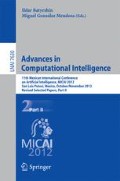Abstract
Authorship attribution has attracted the attention of the natural language processing and machine learning communities in the past few years. Here we are interested in finding a general measure of the style followed in the texts from the three main candidates in the Mexican presidential elections of 2012. We analyzed dozens of texts (discourses) from the three authors. We applied tools from the time series processing field and machine learning community in order to identify the overall attributes that define the writing style of the three authors. Several attributes and time series were extracted from each text. A novel methodology, based in mutual information, was applied on those time series and attributes to explore the relevance of each attribute to linearly separate the texts accordingly to their authorship. We show that less than 20 variables are enough to identify, by means of a linear recognizer, the authorship of a text from within one of the three considered authors.
Access this chapter
Tax calculation will be finalised at checkout
Purchases are for personal use only
Preview
Unable to display preview. Download preview PDF.
References
Juola, P.: Authorship attribution. NOW Press (2008)
Stamatatos, E.: A survey of modern authorship attribution methods. J. of the American Soc. for Information Science and Technology 60(3), 538–556 (2010)
Neme, A., Cervera, A., Lugo, T.: Authorship attribution as a case of anomaly detection: A neural network model. Int. J of Hybrid Intell. Syst. 8, 225–235 (2011)
Manning, C., Schutze, H.: Foundations of statistical natural language processig. MIT Press (2003)
Abarbanel, H.: Analysis of observed chaotic data. Springer (1996)
Kantz, H., Schreiber, T.: Nonlinear time series analysis, 2nd edn. Cambridge Press
Shannon, C.E.: A Mathematical Theory of Communication. Bell System Technical Journal 27, 379–423, 623–656 (1948)
Cellucci, C.J., Albano, A.M., College, B., Rapp, P.E.: Statistical Validation of Mutual Information Calculations. Phy. Rev E. 71(6) (2005), 10.1103/PhysRevE.71.066208
Santos, J., Marques de Sá, J., Alexandre, L., Sereno, F.: Optimization of the error entropy minimization algorithm for neural network classification. In: ANNIE V. 14 of Intelligent Engineering Systems Through Art. Neural Net, pp. 81–86. ASME Press, USA (2004)
Silva, L., Marques de Sá, J., Alexandre, L.: Neural Network Classification using Shannon’s Entropy. In: ESANN 13th European Symp. on Art. Neural Net (2005)
Cover, T., Thomas, J.: Elements of information theory, 2nd edn. Wiley (2006)
Quinlan, R.: Programs for Machine Learning. Morgan Kaufmann Publishers (1993)
Cortes, M.L., Ruiz-Shulcloper, J., Alba-Cabrera, E.: An overview of the evolution of the concept of testor. Pattern Recognition 34, 753–762 (2001)
Kohonen, T.: Self-organizing maps, 2nd edn. Springer (2000)
The Self-Organizing Maps: Background, Theories, Extensions and Applications. Studies in Computational Intelligence (SCI), vol. 115, pp. 715–762 (2008)
Author information
Authors and Affiliations
Editor information
Editors and Affiliations
Rights and permissions
Copyright information
© 2013 Springer-Verlag Berlin Heidelberg
About this paper
Cite this paper
Neme, A., Hernández, S., Carrión, V. (2013). Identification of the Minimal Set of Attributes That Maximizes the Information towards the Author of a Political Discourse: The Case of the Candidates in the Mexican Presidential Elections. In: Batyrshin, I., Mendoza, M.G. (eds) Advances in Computational Intelligence. MICAI 2012. Lecture Notes in Computer Science(), vol 7630. Springer, Berlin, Heidelberg. https://doi.org/10.1007/978-3-642-37798-3_8
Download citation
DOI: https://doi.org/10.1007/978-3-642-37798-3_8
Publisher Name: Springer, Berlin, Heidelberg
Print ISBN: 978-3-642-37797-6
Online ISBN: 978-3-642-37798-3
eBook Packages: Computer ScienceComputer Science (R0)

